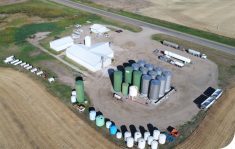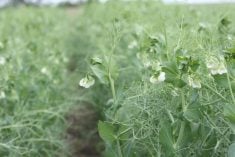Producers are also advised to pay attention to cutworms, bertha armyworms, pea leaf weevils and grasshoppers this year
Recent rains across the western Prairies have alleviated concerns about the dried-out soil fried from last year’s heat dome and a lack of precipitation since then. Farmers’ attention now turns to insect pests.
“Our most consistent insect pest is flea beetles,” said Keith Gabert, agronomy specialist at the Canola Council of Canada. “And the environment also drives instability to consume and challenge that crop establishment.”
Flea beetles can be especially damaging to yield potential when other factors, which can vary by region, are pressuring canola.
Read Also

Volunteers help exotic animal farm rebuild
Exotic animal farm loses beloved camel and pony to huge hail storm that gripped the Brooks, Alta. area as a community member starts a fundraiser to help the family recover from the financial and emotional damage.
“And that region moves around and sometimes individual fields but typically, if our canola crop is stressed in any way, flea beetle damage further exasperates it,” said Gabert.
Few seed treatments are available to help, and more research on a solution is a priority for the canola council.
“We do see some growers use multiple foliar insect applications to try to control or combat their flea beetle this year and, similar to years past, you have reports of reseeding as a result of flea beetles,” he said. “The challenge remains the same, to get this crop up and established and doing well and there are several weeks you have to have a lot of faith to be a farmer.”
There may be more cutworm pressure on crops this year as well, Gabert said.
“I think we have a bit more cutworm pressure than usual, at least in central Alberta,” he said, adding it might be too early to make an overall prairie assessment.
It is a similar story with bertha armyworms, native pests that can affect crops.
There is a good tracking system on the Prairies to forecast possible armyworm problems, but it is too early to tell if they are going to be a concern, said Gabert.
That may be more of a concern in a year or two based on historical tracking of the insect, he added.
Nevin Rosaasen, program specialist at Alberta Pulse Growers, said pulse growers should be aware of pea leaf weevils. If they had an issue last year, it would probably have been a good idea to have considered a seed treatment this year.
Environmental factors, which have seen cooler and wetter conditions across southern and central Alberta and Saskatchewan, will likely produce a beneficial effect for growers dealing with the pest, said Rosaasen.
“They are fairly mobile but at warmer temperatures,” he said of pea leaf weevil. “When it is cool and wet like this, they are wet and sad and they don’t move quite as quickly.”
So far, Rosaasen said this year looks benign overall in terms of weevil populations.
“We aren’t hearing reports of any producers who are thinking about spraying. I haven’t been getting calls about pea leaf weevil and I think producers are a little more informed about the risks,” he said.
Cutworms have been reported in pockets of Alberta and may become a problem for pea and fababean growers.
“We’re certainly advising producers to get out and scout,” said Rosaasen. “Cutworms can be controlled with a foliar insecticide and there has been some spraying this season. They are certainly a pest of concern.”
The threat of grasshoppers to lentils is always a concern with Alberta Pulse Growers recommending spraying if rates are two or more per sq. metre.
“We had really good conditions last year for grasshoppers, eggs are hatching, nymphs are emerging and any producer growing lentils in southern Alberta needs to be on the lookout,” said Rosaasen.
University of Lethbridge environmental science professor Dan Johnson said the recent rain has likely reduced grasshopper numbers.
“The outlook right now is generally low,” said Johnson about the numbers of grasshoppers in southern Alberta and Saskatchewan, adding the populations can be variable. “By that I mean, miles of none and then a suddenly heavy infestation of 50 kilometres or even five kilometres.”
But Johnson said monitoring work he has conducted before and after the June rains hit around the Lethbridge area have seen dramatic reductions.
“The numbers were cut down by more than half,” he said of the effect of heavy rains in southern Alberta. “Some spots are down to 10 percent of what they were.”
More information on crop pests can be found on the Prairie Pest Monitoring Network website at prairiepest.ca.


















